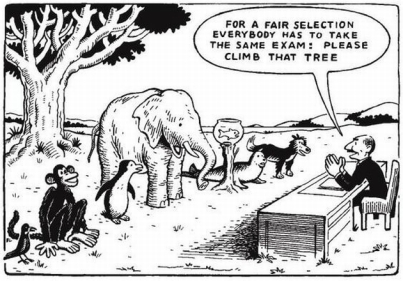Earlier this week, a handful of colleagues from my district and I experienced the educational whirlwind that is Rick Wormeli. I have studied Rick’s writings for some time now, shared thoughts on redos and retakes and standards-based grading before, and incorporated some of his ideas into my own classroom procedures. What I most enjoy about Rick is that he challenges your existing classroom practices, and breaks them down to their foundations: if it’s not about achievement, and moving kids forward, then it’s not part of the plan.
The day began innocently:
Today will be a waste of your time.
Thanks? But Rick’s point was that a single day of PD is simply not sufficient to synthesize these ideas. Change only comes when we take what we learn back to our school, have discussions, think about our policies, and work as a team to do best for our kids. Rick is correct when he states that “school is set-up to meet the needs of those who get it first”. Let’s work on breaking down long-standing policies and drafting new ideas which benefit all learners.

While the day was billed as a “formative assessment” seminar, the concepts really be-bopped from standards-based grading, redos and retakes, learning targets, and formative vs summative assessments. I fear this blog post would be 10 pages long if I tried to summarize everything, so I’ll instead focus on one idea I have incorporated into my classroom routine this year: test retakes.
 How do students react to the grades we give them on assessments? How do our grading practices impede students reaching their learning targets? Rick argues that many of our strategies cause students to wind up in “the pit”; further, many schools perpetutate practices (like losing lateness points, or not allowing corrections) disguised as “teaching responsibility” which cause students to fall deeper into the pit. It’s our duty to lead students through strategies which will get them out of the pit, and professionally unethical to conflate evidence with compliance.
How do students react to the grades we give them on assessments? How do our grading practices impede students reaching their learning targets? Rick argues that many of our strategies cause students to wind up in “the pit”; further, many schools perpetutate practices (like losing lateness points, or not allowing corrections) disguised as “teaching responsibility” which cause students to fall deeper into the pit. It’s our duty to lead students through strategies which will get them out of the pit, and professionally unethical to conflate evidence with compliance.
I have incorporated re-takes into every exam I give this year in AP Statistics, and have allowed re-dos in many Algebra 2 tasks. I continue to evaluate the success of these methods, and I have been largely happy with both the results, and the attitudes of students in embracing the new procedures. When should you allow redos? To Rick, the answer is ALWAYS..it’s our professional responsibility to allow redos – unconditionally. Here are some resources from Rick Wormelli which will get the conversation started:
Educational Leadership, “Redos and Retakes Done Right” – requires ASCD log-in, harass your principal!
“Fair Isn’t Always Equal” – Rick’s landmark book on assessing and grading in the differentiated classroom
Video on Redos and Retakes – Rick defends the redo/retake practice.
What’s the problem with allowing a failing grade? Doesn’t that build character? How do students react to a failing grade, as opposed to a different designator, like “not yet”…
HOW I MANAGE RETAKES
This year, my colleague Joel and I wanted to incorporate retakes into our statistics classes. But there are certainly organizational challenges to be met, and our discussions challenged our beliefs on assessment and its purpose. Here’s what we decided on for our classes this year:
- Each unit test has two parts: multiple-choice and free-response, graded equally like they will be on the AP Exam.
- There are always two free-response questions. Sometimes they are actual former items from AP Exams, sometimes they are questions we write or adapt. A free-response question is one scneario with multiple parts
- After the exams are handed back, students may come in to take the “replacement question” for the exam. The replacement question is a third free-reponse question, which students take on their own time during a daily directed-study period, or after school. The grade on the replacement question replaces the score on the lower-scoring question from the unit test.
- We don’t have a procedure for recovery for multiple-choice. But we are kicking some ideas around.
Here’s why this procedure has worked for us. Unit learning doesn’t end with the chapter test. Students need to go back, reflect upon their misunderstandings, and develop a plan for doing better on the replacement question. It’s great to see kids really reflecting about what went wrong on their test, and coming back to clarify what went wrong….that simply didn’t happen before.
The record-keeping is awkward. But I am getting better at it, and figuring out the best way to manage this extra level of grading. And Rick is now whispering in my head “Don’t drop the principle because you can’t handle the logistics.”
This is the first of what I am sure will be many posts reflecting upon this special day of PD. Looking forward to sharing more ideas, discussions, and anecdotes!
To Rick: Thanks for the great day…and The Three Amigos was underrated
 Adam Shrager, famous as the social director and man-about-town at the AP readings, shared his movie-correlations activity. This has become one of my favorite activities during the stats year. Students are asked to fill out a
Adam Shrager, famous as the social director and man-about-town at the AP readings, shared his movie-correlations activity. This has become one of my favorite activities during the stats year. Students are asked to fill out a 




